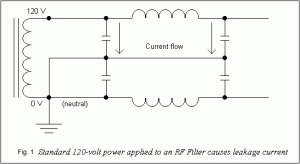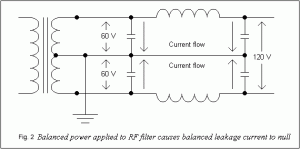WHAT IS BALANCED POWER?
WHAT IS BALANCED POWER?
In simple terms, balanced power is a process that eliminates noise or distortion from incoming electrical current. Before the initial signal hits your devices and equipment for power, balanced power ensures you have the cleanest, most pure power by affecting the current itself. Balanced power is not conditioning power or adding “EQ-ing” to remove noise or interference, rather, balanced power eliminates that noise before you ever hear or notice it.
Equi=Tech has pioneered balanced power since the early 1990’s, during which time we’ve identified a wide variety of applications and industries due to the unparalleled stability of the unadulterated current it provides to all sensitive electronic equipment. Today, we make highly durable rack and wall-mount systems at a wide variety of power needs. Built tough and designed with the most scrutinized components available today, Equi=Tech makes balanced power accessible.
At its core, Balanced AC is 120V split evenly across 2 AC mains. These 2 AC mains are exactly 180 degrees out of phase across the load, with one at +60V and the other at -60V. The sum results in pure 120V. The same pure 120V and frequency that your equipment was designed to operate under as the reference potential (ground) has been located to the midpoint between the two mains, so there is no “neutral” wire.
Reactive currents are what you’ll pull directly from a wall outlet and represent energy that is essentially unused and discharged onto power lines from the impedance load as the source voltage modulates. Whew. What that means is each and every piece of connected equipment adds to the total reactive current on the neutral wire and, in turn, connected to the electrical system’s ground. The varying levels of these reactive currents can be quite substantial. They can be strong enough to crash systems or low enough for meters to not accurately provide precise measurements. From pro audio to space exploration, many people are faced with power issues that affect their workflow and results.
Additionally, electronic power supplies have long been known to also create reactive currents. In the industry, an entire segment has grown up around the study of “power quality”. This has so much more to do with the purity of AC power as it affects how sensitive electronics operate. In order for end users to enjoy the full benefit of their devices, a hard look at AC power has been scrutinized.
Aside from reactive currents, there are other power quality issues involved that can affect equipment performance. Chief among them is Power Factor. When the true power used by a load equals something less than apparent power being supplied, reactive currents make up the difference. This ratio between true power and apparent power is called Power Factor. Ideally, this ratio would be 1:1. However, the presence of reactive currents means that some portion of the power has shifted phase. This is due to the effect of reactive current from a typical non-linear (impedance) load and can cause havoc on many different kinds of electronics. It creates an environment where some of the voltage is lagging 90 degrees from the fundamental volt phase. This shift in voltage away from the active current means that, simply, there is no power present. As you know, voltage and current muse be in phase for power to exist. Low Power Factor means the efficiency of electronics power supplies will be affected.
So, what does all this power business have to do with noisy audio gear or measuring equipment that doesn’t provide reliable/accurate results?
First, let’s take a look at what has been termed “the Noise Circuit” in the recording world. This common example, SEE FIGURE 1, demonstrates how reactive circuits in the ground find their way into audio signal circuits. The amount of this reactive current potential is also proportional to the impedance of the source power system. So in reality, an alternate current path is created through the electronics between the opposite reactive potentials across a power supply via the AC ground. These reactive currents complete the circuit back through sensitive signal-circuit electronics, looping as a matter of speaking, through whatever grounding or signal path is available. This noise, typically called “hum”, is a harmonic structure that can be infinite so all sorts of “sonic qualities” in the noise are possible. For a recording environment, this is not ideal.

Figure 1
The same can be said of sensitive monitoring electronics and anything that requires reliable power to perform a function. The affect of signal noise throughout electronics has lasting results on your intended results.
What’s most interesting about this phenomenon is that it’s been going on for a very long time. And without anything done, really, to address the cause of the problem. Sure, there have been all sorts of Band-Aids® like ground lifts, .01mfd capacitors in grounding circuits, special power supply transformers and many other sorts of remedies that have been tried. Nothing that deals with the source of the problem. At least, not directly, until Balanced Power came along. And even then, balanced power has been viewed as more of a remedy than what it actually is…a properdesigned source of EMF for electronics. Balanced power is better understood (and applied) as a foundation, not as a remedy.
Now, let’s take a look at how balanced AC better fits the power requirements of sensitive equipment…and how it answers noise problems so effectively and efficiently.
In this example, SEE FIGURE 2, note that on opposite mains, reactive currents are out of phase to each other as is the voltage phase across the mains from the driving power source. As it travels back through the mains, the reactive current eventually flows into the ground at the center tap of the transformer. What exists is the equal presence of inversely phased reactive currents flowing from the mains into the ground and everything collapses at the signal reference. This is phase cancellation or common mode rejection.

Figure 2
The phenomenon of phase cancellation/common mode rejection is at the heart of how balanced power eliminates interference. This simple method of dealing with AC harmonics and signal inconsistencies has been overlooked until recently. However, thanks to Equitech-Founder Martin Glasband, balanced AC has been recognized as an approved wiring method in the 1996 National Electrical Code, in Article 530 Part “G”.
The weakest link where analog audio noise is high-gain circuitry. Here’s where low level signal is in the presence (or not) of low level interference and is amplified. The ratio between signal and noise levels here is most critical. There may only be millivolts of signal present, any electrical interference at all could pose a problem. Whereas line level equipment in the presence of low noise levels could be less of a factor. But when you consider that every power supply creates some reactive current potential, the more equipment involved…the more reactive currents are present. So there begins the cascading effect as more channels are mixed, the more background noise will be present. This occurs in the summing amps in a recording console or a live mixing console.
So, does all of this mean that ALL of your equipment needs to be running through balanced AC to get good results? The answer is NO. The standard practice of lifting the shields at the inputs of power amps suits this application very well. Power amps can run on unbalanced AC with little effect on hum. Still, balanced power can be used effectively still to rid a system of hums, buzz and other more subtle artifacts.
You can expect a very clean performance when front of line and backline electronics are running on balanced AC with the line level amps running on unbalanced AC, shields lifted. The only slight drawback to this approach are the limits imposed by noise on the line from the huge amp load. Additionally, with the lower power factor, you can expect a loss in overall sound quality and purity.
Just as importantly, power supplies simply don’t deliver power the same way. But, assuming that your amps are in good shape, there won’t be any audible hums or buzzes.
So in numerical terms, due to the attenuation of noise, an average 12dB increase in dynamic range can be expected from running high-gain equipment balanced and another 3dB can be gained when the amps are included.
As with digital data processing applications, AC power harmonics can cause data corruption. Short of a complete system failure, there is a “grey scale” effect of signal degradation that differs somewhat from analog applications. The main difference is the the frequencies at which problems appear.
For example in 16 bit audio, 16 bit “chunks” of data are processed at 44.1kHz. The bit stream rate in audio is about 700,000 bits per second (16 x 44,100). Various other digital clocking functions may run at MUCH higher frequencies and are too subject to high frequency AC noise. How this sounds to our ears is, well, subjective…but is also very measurable.
For fun (yes, this is how we have fun), we recently completed some tests on a well-known manufacturer’s DAT machine. The results were wildy interesting. First, under standard power, peak jitter was measured under tests in a live performance situation. That resulted in a peak jitter of 18ns with an average jitter at a measured 6ns. We repeated the test using balanced power that yielded peak jitter at 6ns and an average of only 3ns. When high frequency interference is present, proportionally there will be timing errors. Digital jitter appears in a manner not unlike intermodulation distortion in analog circuits. Jitter is compounded as more equipment is added to the digital signal chain the same way low frequency noise compounds in analog systems. Digital jitter is essentially “digital hum” and will adversely affect results.
The impact Balanced Power will have in sophisticated electronics applications is vast and still so much more to explore. In the broadest sense, balanced power is so much more than just a patch. While mildly fair and true that is can solve existing problems, the better application is a elegant means to provide clean power to electronics. Electrically speaking, it’s a more solid foundation for sensitive electronics.
You don’t have to just “accept” current conventional AC because that’s how things have been done for over a century. The performance from everyday equipment all the way up to expensive/sensitive electronics using balanced power can be quite astonishing. Click here to see what current users have to say.
Start your build with balanced AC and you’ll never know the problems unbalanced systems can provide. Otherwise, you are chasing a root issue that can sometimes easily be overlooked.